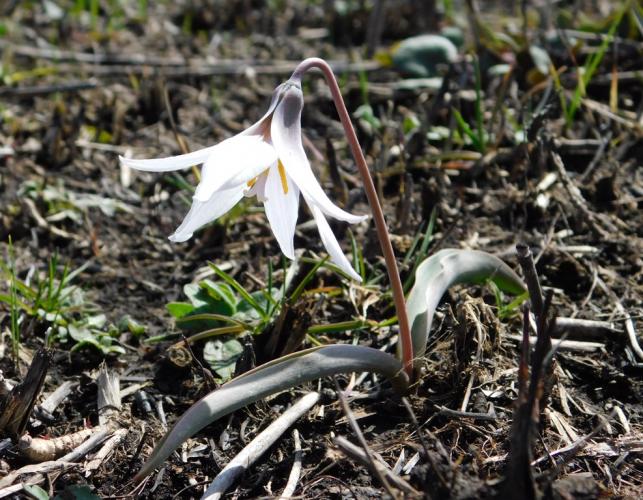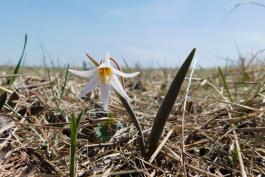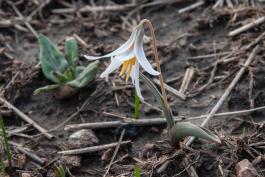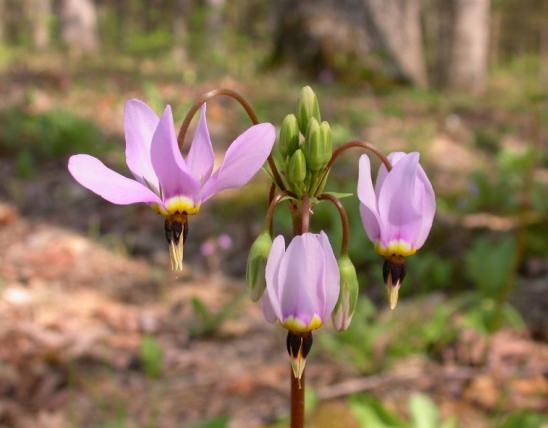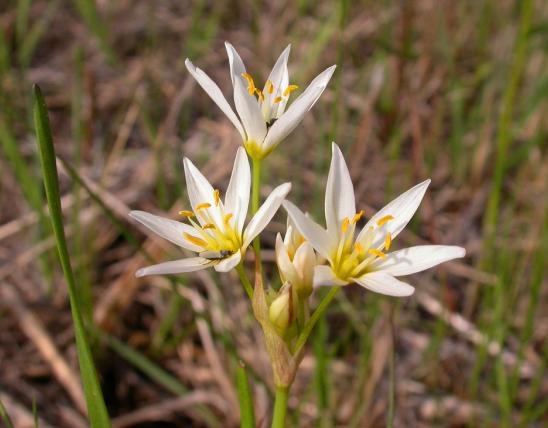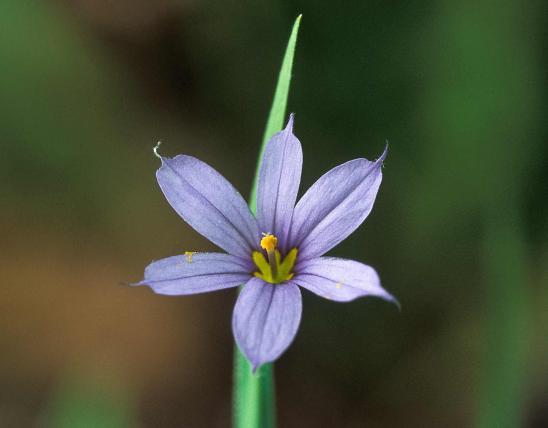
Prairie dogtooth violet, or prairie trout lily, is a small, early blooming lily that lives in prairies and glades. Its flowers are white and its narrow leaves are folded lengthwise and seem waxy on the undersurface.
The plants are perennial, growing from a bulblike corm. Each plant typically has 2 leaves, which usually appear opposite at the base of the plant. Each leaf is linear-lance-shaped to narrowly ellipse-shaped, to about ¾ inch wide, typically folded lengthwise, waxy on the undersurface, and not mottled in coloration. The leaves typically arch outward, the outer tips often touching the ground.
The flowers have 6 tepals (3 petals plus 3 petal-like sepals) that are lance-shaped, white, sometimes tinged with pink, purple, blue, or green; they spread outward but are not reflexed (curved backward). The flowers are at the tip of a single stalk, which usually nods so that the flower faces downward. Blooms March–May.
The fruits are obovate (egg-shaped, with the wider part at the outer end) capsules, the tip broadly rounded, positioned on the ground as the flowering stem lengthens and becomes strongly arched after flowering.
Similar species: Three other species of dogtooth violets, or trout lilies (Erythronium spp.), have been recorded for Missouri:
- The one most similar to prairie dogtooth violet is E. albidum, the white trout lily or dogtooth violet. It is distinguished by its brownish-mottled leaves that are flattened (not folded) and usually held erect, and by its sepals strongly reflexed (curved back). It grows in wooded habitats instead of prairies.
- Our other two members of the genus are E. americanum, which is scattered in wooded habitats in the Ozarks and Ozark border regions, and E. rostratum, which is scattered in similar habitats in the Ozarks and in the unglaciated plains of southwest Missouri. Both have yellow flowers, and both are called yellow trout lily, yellow dogtooth violet, or yellow adder’s tongue. E. rostratum’s fruits taper to form a pointy beak at the outer tip, whereas those of E. americanum are broadly rounded or straight across at the tip.
Stem length: 4–8 inches, flowering at the shorter length and reaching the longer length as the fruits mature.
Scattered nearly statewide, but apparently absent from the Mississippi lowlands of the Bootheel.
Habitat and Conservation
Occurs in prairies, glades, dry to mesic upland forest, frequently in rocky, open sites.
This is our only dogtooth violet strongly associated with prairies and open, upland habitats. It is well adapted to prairie fires. It is one of the first prairie wildflowers to bloom each year. Its appearance in an area can be a sign that the land has never been plowed.
Prairie dogtooth violet used to be considered a variety of white dogtooth violet (its former scientific name was E. albidum var. mesochoreum), but there is ample reason to separate it as a distinct species. In addition to the characters noted in the description above, prairie dogtooth violet also is diploid, while white dogtooth violet is tetraploid — the chromosome numbers are different.
The differences continue belowground: prairie dogtooth violet reproduces vegetatively mostly by offsets (new corms forming beside the older one) and by droppers (runner-like structures that grow vertically downward from the parent corm and produce a new corm at the tip), and only rarely by stolons (horizontal or arched runners that extend from the parent corm and form a new corm at the tip) — and this is unique among our dogtooth violets. Dogtooth violet species that usually reproduce by horizontal stolons typically occur in populations composed of mostly nonflowering plants that send up only a single leaf. However, populations of prairie dogtooth violet are usually encountered with numerous flowering individuals.
Prairie trout lily has a more limited distribution than white trout lily. The latter occurs throughout most of the eastern United States and adjacent Canada, while prairie trout lily’s range extends only from Illinois to Nebraska and south to Missouri and Texas — much of the historic tallgrass prairie region and some eastern parts of the mixed-grass prairie region.
Status
Native Missouri spring-blooming wildflower. Prairie wildflower; glade wildflower.
Human Connections
Dogtooth violets are sometimes cultivated as ornamentals, and wild, native populations have been pillaged by unscrupulous “diggers.” Ethical nurseries, however, are selling native plants propagated primarily by vegetative reproduction of cultivated plants.
The leaves and corms of various dogtooth violet species apparently have been cooked and eaten, but the corms have also been reported to have emetic properties (causing vomiting).
The name “trout lily” is not very apt for this species, as it refers to the mottled coloration that’s common on the leaves of its relatives. The name “dogtooth violet” is rather confusing, since this species is certainly not a true violet (genus Viola). The term “dogtooth” apparently refers to the pale, conical underground corms, which resemble the canine teeth of dogs.
The genus name, Erythronium, is from the Greek root erythro-, meaning “red”; it originally applied to a European relative that had reddish flowers. That European species, by the way, is E. dens-canis, whose species name means “dog-tooth,” in reference to the elongated shape of the whitish corms.
The species name, mesochoreum, first appeared in print in 1891, and the full scientific name was meant to translate as “Midland Erythronium.” That 1891 magazine was published by an institution then called Midland College, in Atchison, Kansas. (The school is now called Midland University, relocated in Fremont, Nebraska.) The plant's original describer, E. B. Knerr, was a science professor at Midland College. He had first noticed the plant growing on the college campus; it looked different from the other dogtooth violets he had seen, and he believed it to be a new species. So this flower was apparently named for Midland College, and only indirectly for its general location in the continent.
Dr. Knerr loved the dogtooth violets, writing, “Perhaps there is no more interesting genus of plants among Liliaceae. . . . [They] are the first of the order to appear in the spring and in point of beauty are second to none. Besides, there are features of propagation quite as puzzling and wonderful as any to be found.” He studied the differences in corm development and asked why some species, such as prairie dogtooth violet, produce many plants that flower, while others produce mostly nonflowering plants represented by dozens of single leaves.
Ecosystem Connections
A variety of bees, including honeybees, mason bees, cuckoo bees, digger bees, plasterer bees, halictids, and andrenids visit the flowers. One species, the trout-lily andrena or Easter bee (Andrena erythronii), is an early spring miner bee notable for favoring the members in this genus. Flies, butterflies, and skippers also visit the flowers for nectar, pollen, or both.
Dogtooth violets are one of several groups of spring wildflowers whose seeds have white, oily appendages called elaiosomes and are distributed by ants. The ants collect and carry the seeds to their nests, eat away the nutritious portion of the seeds, then discard the still-viable portion of the seeds to the “garbage” chamber of their nests, which is a perfect, protected place for the young plants to sprout and thrive. Violets and Dutchman’s breeches are other plants with elaiosomes.
Like other early spring wildflowers that bloom in prairies, prairie dogtooth violet must accomplish its mission before it is subsumed by a sea of much taller vegetation, including tallgrasses and sunflowers that can be 8 feet high. Occasional fires that burn away the masses of dry vegetation built up from previous growing seasons lead to banner blooming seasons for early spring wildflowers on the prairies.
Globally, there are approximately 25–30 species of in genus Erythronium. They occur in North America, Europe, and Asia. The northwestern United States has several lovely members of this genus, including glacier lily (E. grandiflorum), avalanche or alpine fawn lily (E. montanum), coast fawn lily (E. revolutum), Oregon trout lily (E. oregonum), and California fawn lily (E. californicum).



